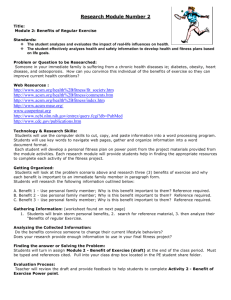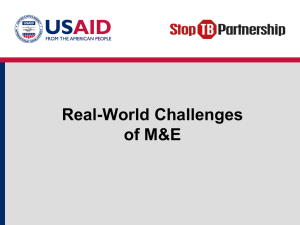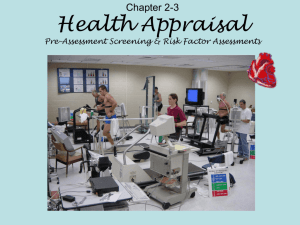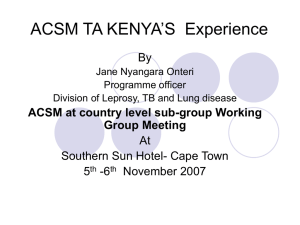What is civil society?
advertisement
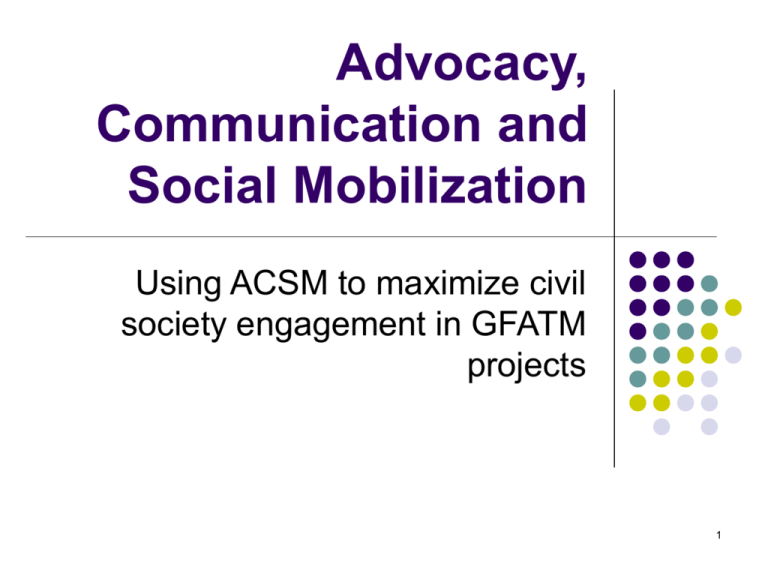
Advocacy, Communication and Social Mobilization Using ACSM to maximize civil society engagement in GFATM projects 1 Objectives To promote and facilitate engagement of civil society Examine the role of civil society in policy discussions and programme design Examine the role that different civil society actors/audiences can play in implementing ACSM activities and integration of TB control into governance and societal structures Expand the effectiveness of ACSM approaches to increase TB case detection, service usage and engagement of civil society 2 What is civil society? 'A civil society is a public space between the state, the market and the ordinary household, in which people can debate and take action'. any voluntary collective activity in which people combine forces to achieve change on a particular issue 3 Importance Health interventions are social interventions Broad-based support needed to maximise impact of health interventions Strong political and social support are critical to program success Civil Society is a force multiplier that can increase impact—ACSM is the means to an end. 4 More Effective Advocacy Gov’t makes TB control high priority Gov’t ensures adequate drug supply Gov’t provides quality DOTS services STOP TB Monitoring More Effective Communication Households learn about TB symptoms, transmission and treatment Gov’t, community, households team up to eliminate TB stigma People with symptoms seek health care Social Mobilization Civil society works with Gov’t ,and households to eliminate TB in the community Providers, community and people team up to detect potential cases and diagnose correctly Civil society allocates resources and nurtures appropriate environment to eliminate TB in community Providers, community and people team up to encourage correct treatment regimen Gov’t, community, civil society and households integrate into culture appropriate health values and practices # Cases drop long term # of TB free communities increase Possible Contributions of Social Mobilization To Desired Outcomes to STOP TB 5 Philippines Social Mobilization Project Micro level engagement of civil society Question: How to increase case detection through community engagement? CCM turned to community-based NGOs. Partner Profile: World Vision—faith-based NGO with strong community level visibility. Project: Formation of community based TB "task forces". Active TB case referral House to House communication and education for TB 6 Increase in detection of TB suspects as a result of civil society engagement Barangay Pangobilian, Brooke’s Point, Palawan Case Finding Activities 2001 2002 2003 2004 2005 160 140 120 100 80 60 40 20 0 no. of symptomatics no. of TF referrals no. of new smear positive no. of new smear positive from TF referrals 7 Unforeseen benefit! Community members lobby local government to increase TB services Community members involved in active case detection (based on clinical presentation) Engagement of businesses, schools, churches, civic organizations Beginning of a political health movement for wider health issues 8 Mobilizing civil society to implement ACSM activities in Kenya A national approach 9 Journalists can advocate for equitable access Problem NLTP's access to to TB/HIV detection1: and treatment people living in urban slums TB/HIV povertybecause often go hand in hand isand limited of resource constraints A peri-urban area in Southern Africa. 10 Local NGOs have access slum dwellers, but need training to deliver TB information to patients and need to become more involved in the planning and policy process Cured TB patients on World TB Day in Kinshasa. 11 There's no problem in mobilizing civil society in Kenya 9,000 registered NGOs and CBOs in Kenya out of which 6,000 are operationally active. About 500 are members of the Kenya Consortium to Fight AIDS, TB and Malaria (KECOFATMA). KECOFATUMA has used a GIS system to map and analyze its members countrywide. The NLTP and its implementing partners work with KECOFATUMA and therefore more than 500 organizations that are members of this umbrella body. …but civil society activities for ACSM are uncoordinated 12 The NLTP had already established an ACSM Task Force to manage the COMBI project There was past history of good relations in the Task Force Good management structures had been established Members knew each other and communicated effectively New members were simply included in the existing ACSM Task Force: World Health Organization (WHO), African Medical and Research Foundation (AMREF), Centers for Disease Control (CDC), Family Health International (FHI), Global and National Stop TB Partnership; International Medical Corps (IMC), Kenya Medical Research Institution (KEMRI), KNCV, National AIDS, STI Control Programme (NASCOP); National Empowerment Network of People Living with HIV/AIDs in Kenya (NEPHAK); PATH; Population Services International (PSI); United States Agency for International Development (USAID); in coordination with the Ministry of Health's Division of Health Promotion and the National Leprosy and Tuberculosis Control Programme (NLTP). 13 Lines of communication were already established NLTP PATH – lead agency on ACSM Other agencies NGOs …Flow of funds Were discussed openly in the Task force at the outset Given to the lead agency for each component of the strategic plan 14 The Task Force gained consensus on the target audiences based on the problem 15 NEPHAK and IMC : train 100 first line health providers include religious, civic and cultural organizations PATH, FHI and PSI: evaluation of communications needs PATH, FHI, and IMC: use peer education etc in communities, schools and with health workers PATH: develop community-linked mass media campaigns PATH and NLTP: mobilize the media PSI and AMREF: plan the mass media campaign Kenya Medical Research Institute and NLTP: take out quarterly TB ads in national papers FHI: review, upgrade and develop new IEC materials for mass pamphleteering FHI, Min of Lab and Manufacturers Association etc: train on peer-to-peer education in workplace. 16 Conclusion Mapping of: The problem Target audience Stakeholder expertise Policy, judiciary and legal barriers to TB control …leads to improved coordination of activities and greater access to the urban poor …but local NGOs still need support to build capacity to deliver services and to lead some aspects of the programme design and policy process 17 Exercise Instructions: Take a sheet of paper and map an overview of all the different players and actors involved in your TB program Draw lines and arrows indicating the connects of authority, influence and support. Are there other actors and players that can be accessed? 18 Report out Conclusions and discussions 19
